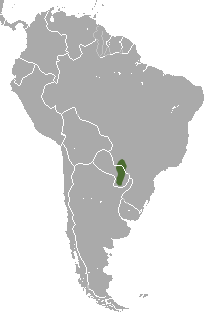Paraguayan fat-tailed mouse opossum facts for kids
The Paraguayan fat-tailed mouse opossum (Thylamys macrurus) is a small, furry animal that belongs to the opossum family, called Didelphidae. It lives in the forests of Brazil and Paraguay. This special opossum is known for its unique tail, even though it doesn't store fat there like some of its relatives.
Quick facts for kids Paraguayan fat-tailed mouse opossum |
|
|---|---|
| Conservation status | |
| Scientific classification | |
| Genus: |
Thylamys
|
| Species: |
macrurus
|
 |
|
| Paraguayan fat-tailed mouse opossum range | |
Contents
What It Looks Like
The Paraguayan fat-tailed mouse opossum is a small creature. Its body, from head to tail, is about 12 to 13.5 centimeters (about 5 inches) long. Its tail is usually a bit longer than its body, reaching about 14 to 15.5 centimeters.
Fur and Colors
Most of its fur is gray. However, the fur on its shoulders has a reddish-gray color. The fur on its belly, which is called the ventral side, is pure white or a creamy white color. A cool feature is the black fur ring around each of its eyes, making them stand out!
Its Special Tail
The tail of this opossum is mostly hairless, except for the first centimeter or so near its body. The underside of the tail is white. The top part of the tail, called the dorsal side, is gray for about the first third to half of its length. The rest of the tail, towards the tip, is white. Even though its name includes "fat-tailed," meaning other opossums in its group store fat in their tails, there's no proof that this specific species does.
Where It Lives
This opossum makes its home in the forested areas of two South American countries: Brazil and Paraguay. It prefers places with lots of trees and plants. Because it's quite rare and hard to find, scientists have only studied a few of these animals.
Conservation Status
The Paraguayan fat-tailed mouse opossum is currently listed as "Near Threatened" by the IUCN (International Union for Conservation of Nature). This means that while it's not in immediate danger of disappearing, its population could become threatened if we don't protect its habitat.
See also
 In Spanish: Marmosa coligruesa colilarga para niños
In Spanish: Marmosa coligruesa colilarga para niños


